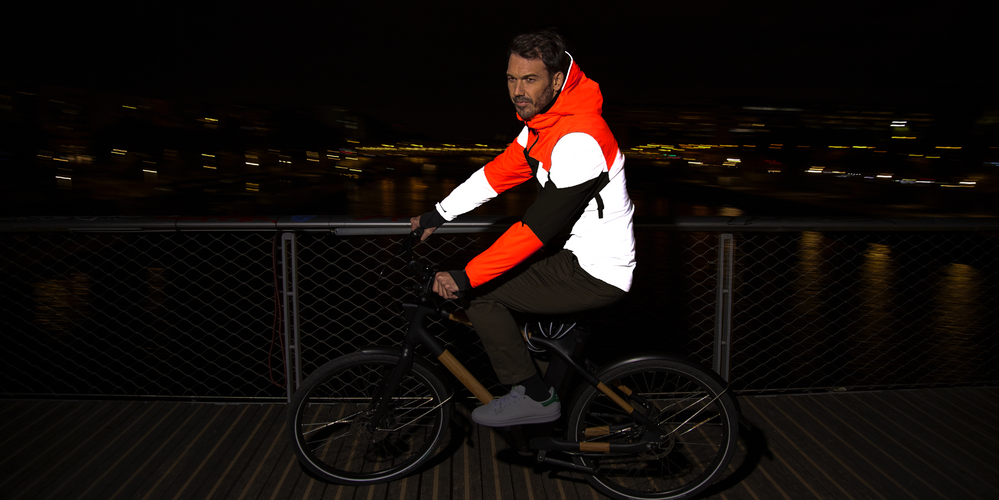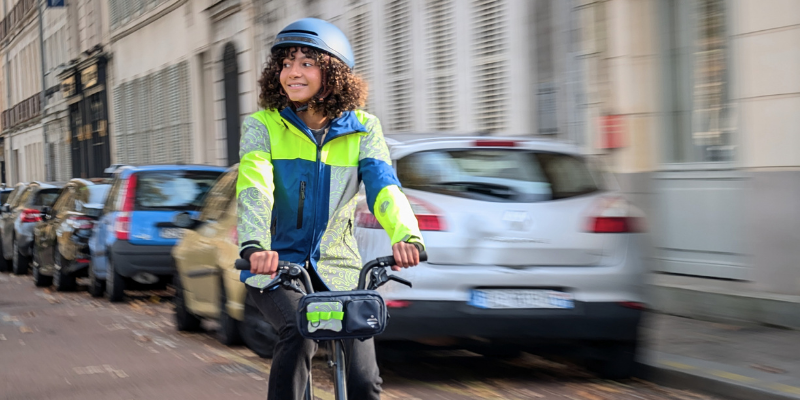
Getting the right equipment for cycling in the rain: a challenge for commuting
For employees who use their bicycles as a means of daily transportation, even in rainy weather, good equipment is essential. Whether commuting to work or traveling between appointments, staying comfortable and dry allows them to maintain a steady pace while avoiding weather-related inconveniences.
At a time when more and more companies are promoting soft mobility through the sustainable mobility package or CSR approaches, it is relevant to support this dynamic with practical advice on suitable equipment.
Bet on a technical rain cape
The poncho-style rain cape is particularly suitable for daily commutes. It can be worn quickly, takes up little space when folded, and effectively protects the upper body and legs. Models like the VUELTA cape or the ROMEA poncho allow you to remain functional even in heavy downpours.
Don't neglect the lower body
A full-length rain suit , combined with overshoes, provides complete protection. For commuting, this is a worthwhile investment: it allows you to arrive in a presentable state, without having to change completely once you arrive at the office.
Find all our rain pants: collection
A well-designed waterproof jacket
For regular cyclists, a lightweight, breathable jacket remains a must-have. It should regulate heat while providing a moisture barrier. A model suited to urban mobility guarantees optimal comfort without restricting movement.
Protect your personal belongings
If you are carrying a computer or business documents, it is essential to use a waterproof backpack , or at least a protective bag cover. This equipment prevents any material damage due to humidity.
Integrating cycling into corporate culture
Encouraging cycling, even in bad weather, is one of the levers that companies can use to promote workplace well-being and sustainable modes of transport. This also requires a culture of prevention and the ability of organizations to educate their employees about good habits.
Organizations specializing in workplace health and safety prevention, such as Goalmap, support companies on these issues. By implementing training around active mobility and the prevention of MSDs , they help private sector companies and public administrations to structure their actions to encourage the use of bicycles on a daily basis.
👉 The Goalmap blog offers numerous training courses and resources on quality of life at work , safety and health, useful for companies wishing to take concrete action in favor of the mental and physical well-being of their teams.
Adapting your cycling practice in rainy weather
Having the right equipment is one thing, but it's just as important to adapt your cycling behavior when it's raining. Here are some concrete tips that can easily be shared as part of internal corporate communications.
Adapt your speed and trajectory
In wet weather, braking can be less effective, and some surfaces can become slippery. Adjusting your speed, cornering smoothly, and avoiding sudden braking are reflexes to learn.
Choose your route wisely
In the rain, some routes may present more risks than others (fallen leaves, uneven roads, narrow passages, etc.). Choosing well-maintained cycle paths and familiar routes will allow you to cycle more calmly.
Managing descents well
When descending, it's best to anticipate braking and adopt a stable posture. Braking gradually before the slope and avoiding excessive front brake pressure helps maintain control of the bike, even in difficult conditions.
In conclusion
Encouraging cycling, even in the rain, requires a pragmatic approach: suitable equipment, tailored driving, and gradual awareness-raising. In companies, this approach can be part of a broader QWL and sustainable mobility policy.
Partners like Goalmap can support these developments by providing their expertise in health and safety prevention and by supporting companies in implementing responsible practices.


